|
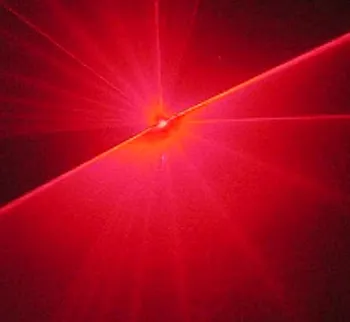
In 1967, a few years after the first
working laser was invented, Endre Mester in Semmelweis
University, Budapest, Hungary wanted to test if laser
radiation might cause cancer in mice [1]. He shaved
the dorsal hair, divided them into two groups and gave
a laser treatment with a low powered ruby laser (694
nm) to one group. They did not get cancer, and to his
surprise the hair on the treated group grew back more
quickly than the untreated group. This was the first
demonstration of "laser biostimulation".
Since then, medical treatment with coherent-light sources
(lasers) or non coherent light (light-emitting diodes,
LEDs) has passed through its childhood and adolescence.
Currently, low-level laser (or light) therapy (LLLT),
also known as "cold laser", "soft laser", "biostimulation" or "photobiomodulation" is
practiced as part of physical therapy in many parts
of the world. In fact, light therapy is one of the
oldest therapeutic methods used by humans (historically
as solar therapy by Egyptians, later as UV therapy
for which Nils Finsen won the Nobel prize in 1904 [2]).
The use of lasers and LEDs as light sources was the
next step in the technological development of light
therapy, which is now applied to many thousands of
people worldwide each day.
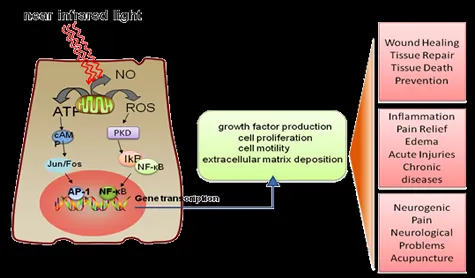 |
LLLT mechanism and application.
Incoming red and NIR photons are absorbed in cell
mitochondria, producing reactive oxygen species
(ROS) and releasing nitric oxide (NO), which leads
to gene transcription via activation of transcription
factors (NF-?B and AP1).
Source |
Low-level
lasers are also called cold lasers, soft lasers,
biostimulation lasers, low-intensity lasers, etc.
Low-level laser therapy (LLLT) is the use of a low-powered
laser that emits specific wavelengths of light in the
visible red and/or far infrared range for therapeutic
purposes. This involves the application of low power
light to areas of the body in order to stimulate healing.
It is also known as cold laser, soft laser or low intensity
laser.
The reason why the technique is termed LOW-level is
that the optimum levels of energy density delivered
are low when compared to other forms of laser therapy
as practiced for ablation, cutting, and thermally coagulating
tissue. more
Controlled research into the
effects of low level laser is currently being conducted
in various European centres and in Japan.
Knee injuries and conditions treated by low-level
laser include tendonitis, bursitis, meniscus tears,
runners knee/chondromalacia patella, knee joint effusion,
iliotibial band syndrome, osgood schlatters disease,
osteoarthritis and rheumatoid arthritis.
Low Level Laser Therapy for Osteoarthritis and
Rheumatoid Arthritis: A Metaanalysis
LUCIE BROSSEAU, VIVIAN WELCH, GEORGE WELLS, PETER TUGWELL, ROBERT
de BIE, ARNE GAM, KATHERINE HARMAN, BEVERLEY SHEA, and MICHELLE MORIN
Objective. Osteoarthritis (OA) and rheumatoid arthritis (RA) affect
a large proportion of the population. Low level laser therapy (LLLT)
was introduced as an alternative noninvasive treatment for RA and
OA about 10 years ago, but its effectiveness is still controversial.
We assessed the effectiveness of LLLT in the treatment of RA and
OA.
Results. In patients with RA, relative to a separate control group,
LLLT reduced pain by 70% relative to placebo and reduced morning
stiffness by 27.5 min (95% CI –52.0 to –2.9), and increased
tip to palm flexibility by 1.3 cm (95% CI –1.7 to –0.8).
Conclusion. LLLT should be considered for short term relief of
pain and morning stiffness in RA, particularly since it has few
side effects |
Low-level powers use very low power and
no heating of or damage to the tissue occurs. Low-level
laser treatment increases cell metabolism.
Karu has shown that visible and near-infrared
radiation is absorbed in the respiratory chain
molecules in the mitochondria (e.g., cytochrome
c oxidase), which results in increased metabolism,
which leads to signal transduction to other
parts of the cell, including cell membranes,
and ultimately to the photo response (e.g.,
stimulation of growth).
Karu T.I. (2003). Low-power
laser therapy. In: Biomedical Photonics Handbook
(T. VoDinh, ed.) CRC Press, Boca Raton, FL,
48, pp. 1-25 |
Low-level lasers emit light in the red
and infrared range. Red and infrared light penetrate
deeply into human tissue, where the light energy is
absorbed and turned into biochemical energy. By increasing
cellular energy in the treated area, low-level laser
therapy is believed to speed healing and reduce inflammation
and pain. There are no known side effects
lasers
are not magical; it is the light that they produce
that yields the biological effect
How does it work?
Photons, which are particles of electromagnetic energy,
are emitted from the low power laser. These particles
enter the tissues and are absorbed in the mitochondria,
which are tiny structures within the substance of each
individual cell. The energy is converted to chemical
energy within the cell. The permeability of the cell
membrane changes which in turn produces various physiological
effects. These physiological changes affect a variety
of cell types including macrophages, fibroblasts, endothelial
cells and mast cells.

Low-level laser therapy (LLLT)/ Photobiological
techniques are sometimes less invasive than those used
in other areas of science, allowing the sample to respond
without incurring much damage. It is no coincidence
that two of the most important macromolecules in biology
- DNA and chlorophyll - respond readily to light. In
fact absorption of light by plants is the driving force
for much of the life on earth.
COLD LASER THERAPY is a treatment
whereby a cold laser is utilized to treat chronic
and acute pain. Cold laser therapy is used for persons
suffering from back and neck pain, musculoskeletal
pain, joint pain associated with arthritis, fibromyalgia,
tendonitis, busiitis, neuropathy, Achilles tendon
pain, migraine headaches, sprains and strains, carpal
tunnel and other associated pains. Cold laser therapy
is also used in the treatment of conditions such
as TMJ, reflex sympathetic dystrophy (RSD) and other
inflammatory and scarring conditions
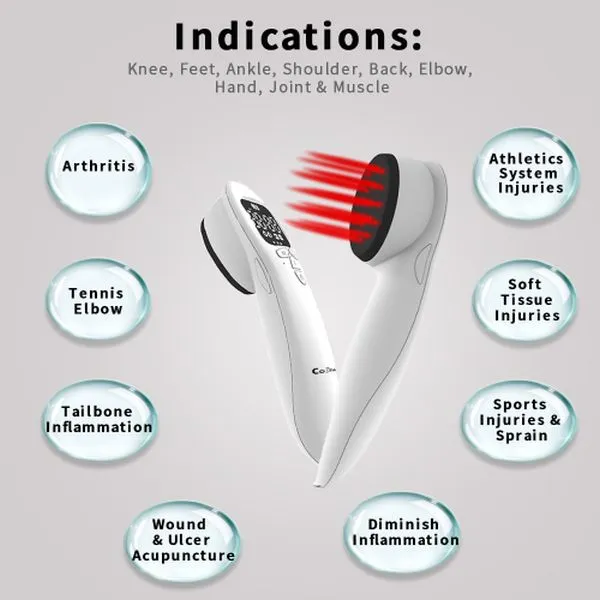
What is it used for?
Low-power laser therapy is used by physical therapists
to treat a wide variety of acute and chronic musculoskeletal
aches and pains, by dentists to treat inflamed oral
tissues and to heal diverse ulcerations, by dermatologists
to treat edema, non-healing ulcers, burns, and dermatitis,
by orthopedists to relieve pain and treat chronic inflammations
and autoimmune diseases, and by other specialists,
as well as general practitioners. Laser therapy is
also widely used in veterinary medicine (especially
in racehorse-training centers), and in sports-medicine
and rehabilitation clinics (to reduce swelling and
hematoma, relieve pain, improve mobility, and treat
acute soft-tissue injuries). Lasers and LEDs are applied
directly to the respective areas (e.g., wounds, sites
of injuries) or to various points on the body (acupuncture
points, muscle-trigger points).
Cold Laser therapy, whether using low intensity radiation
in the visible or near-infrared region can be beneficial
in a number of clinical situations, from pain remission
to wound healing. Unfortunately, the absence of this
type of phototherapy from the mainstream of medicine
makes it unavailable to patients who could benefit
from it.
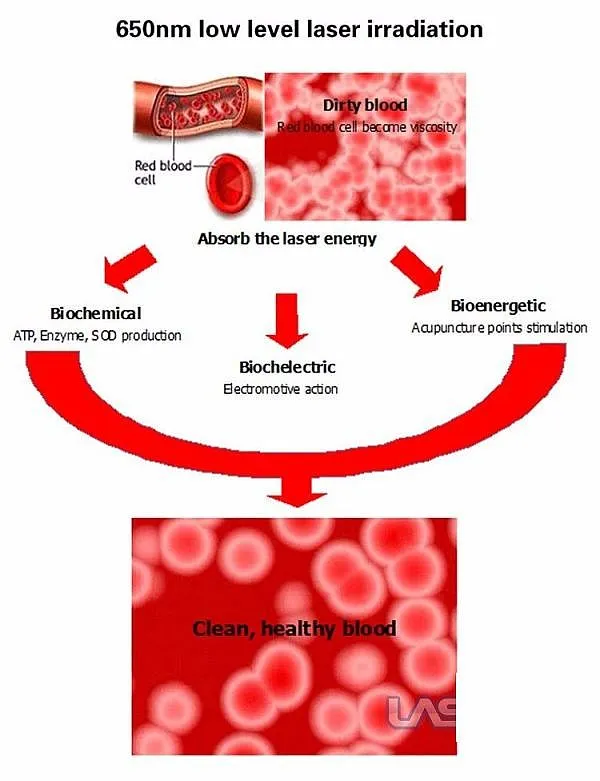
 Soft
tissue injuries, including sprains and strains, tendonitis
and haematomas Soft
tissue injuries, including sprains and strains, tendonitis
and haematomas
 Joint
conditions, including arthritis, tenosynovitis and capsulitis Joint
conditions, including arthritis, tenosynovitis and capsulitis
 Chronic
pain, including Trigeminal neuralgia and chronic neck and back
pain Chronic
pain, including Trigeminal neuralgia and chronic neck and back
pain
 Wound
management, including skin ulcers, pressure sores and burns Wound
management, including skin ulcers, pressure sores and burns
 Skin
infections, including cold sores, warts, verruca Skin
infections, including cold sores, warts, verruca
 The
laser may also be focussed on acupuncture points to assist with
smoking cessation and the relief of short or long-term pain The
laser may also be focussed on acupuncture points to assist with
smoking cessation and the relief of short or long-term pain
 |
LLLT for central nervous system
(CNS) neurological disorders. NIR light can penetrate
through the skull into the brain, reducing neuronal
cell death, reducing inflammation and increasing
the likelihood of neurogenesis. The retinal nerves
and the spinal cord are classified as part of the
CNS, and light is delivered for similar reasons
into the eye or to the neck or back at the site
of the spinal cord lesion. Source |
 LLLT
for pain relief, inflammation and healing. In recent
years, there has been growing interest in the use of
laser biostimulation as a therapeutic modality for
pain management (Strong, 2002). Alterations in neuronal
activity have been suggested to play a role in pain
relief by laser therapy. LLLT
for pain relief, inflammation and healing. In recent
years, there has been growing interest in the use of
laser biostimulation as a therapeutic modality for
pain management (Strong, 2002). Alterations in neuronal
activity have been suggested to play a role in pain
relief by laser therapy.
 Many
published reports document the positive findings for
laser biostimulation in pain management. This level
of evidence relates to chronic neck pain (Chow et al.,
2005), tendonitis (Bjordal et al., 2006), chronic joint
disorders (Bjordal et al., 2003), musculoskeletal pain
(Gerber et al., 2001), and chronic pain (Aronoff, 1999).
Randomised controlled trials provide evidence for the
efficacy of laser therapy in chronic low back pain
(Frazer et al., 2003). Many
published reports document the positive findings for
laser biostimulation in pain management. This level
of evidence relates to chronic neck pain (Chow et al.,
2005), tendonitis (Bjordal et al., 2006), chronic joint
disorders (Bjordal et al., 2003), musculoskeletal pain
(Gerber et al., 2001), and chronic pain (Aronoff, 1999).
Randomised controlled trials provide evidence for the
efficacy of laser therapy in chronic low back pain
(Frazer et al., 2003).
 LLLT
significantly improves wound healing in both diabetic
rats and diabetic mice. LLLT was also effective in
X-radiation impaired wound healing in mice. Furthermore,
the total collagen content was significantly increased
at 2 months, when compared with control wounds. The
beneficial effect of LLLT on wound healing can be explained
by considering several basic biological mechanisms,
including the induction of the expression of cytokinesis
and growth factors known to be responsible for the
many phases of wound healing. Figure below shows the
mechanism of LLLT on wound healing (Lucas et al., 2002). LLLT
significantly improves wound healing in both diabetic
rats and diabetic mice. LLLT was also effective in
X-radiation impaired wound healing in mice. Furthermore,
the total collagen content was significantly increased
at 2 months, when compared with control wounds. The
beneficial effect of LLLT on wound healing can be explained
by considering several basic biological mechanisms,
including the induction of the expression of cytokinesis
and growth factors known to be responsible for the
many phases of wound healing. Figure below shows the
mechanism of LLLT on wound healing (Lucas et al., 2002).
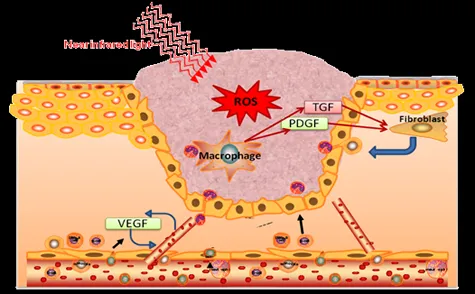 |
LLLT for Wound Healing. Cells in
the wound respond to light induced reactive oxygen
species (ROS) leading to the expression of growth
factors, such as transforming growth factor beta
(TGF), and platelet derived growth factor (PDGF),
which encourage synthesis of more collagen, increased
formation of blood vessels, and less inflammation,
all of which increase wound healing. Source |
Most health care plans do not cover LLLT
because the FDA considers LLLT investigational, experimental
and unproven (though approved for use since 2002 by
the FDA). More large clinical trials that follow stringent
scientific guidelines are needed. Though there have
been many trials they have been considered inadequate.
(1)
The cost of one treatment is typically about
$50 with an average of 10 treatments given. The
number of LLLT treatments needed depends upon
the condition being treated, the severity of
the condition and individual response. The effect
of low-level laser therapy is accumulative. Though
some people have immediate results, improvements
are often not noticed until after 3-5 treatments.
Now you can own your
own system for the approximate cost of treatments |
Cold laser therapy increases serotonin
levels which allow the body to heal itself. Cold laser
therapy is non-thermal and noninvasive. A combination
of cold laser and electric stimulation, cold laser therapy
is one of the most effective healing therapies in the
medical community today. Completed in one to three
sessions, cold laser therapy is not only significant
in reducing treatment times, it is cost effective as
well.
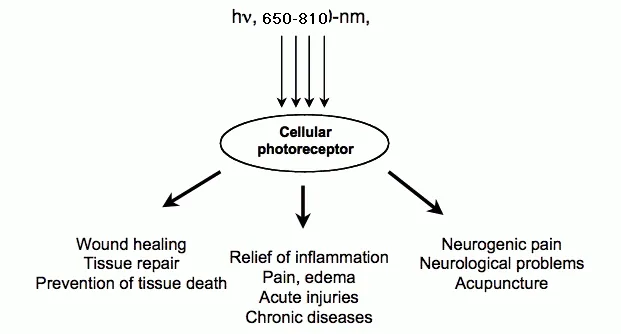
Therapeutic Principle:
"Our Semiconductor Laser Therapeutic Instrument has
been developed based on modern laser medicine and clinical
practice. It adopts low-level laser with the wavelength
of 650nm, through specific parts of irradiation and
using light radiation of laser and wavelength relation
to change the biological characteristics and peel off
the fat layer and cholesterol in the red blood
cells, to improve the activity and oxygen carrying
capacity as well as the deformability of cells, reduce
the concentration of middle molecules in the blood,
improve hem rheological properties and lower triglycerides
and cholesterol, in order to effectively treat and
prevent diseases.

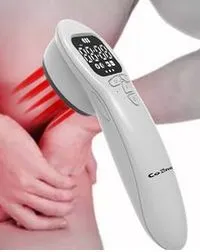 |
Affordable
Portable 17 Beam Cold Laser Therapy
Knee, Feet, Ankle, Shoulder, Back, Elbow,
Hand, Joint & Muscle
Arthritis
Tennis Elbow
Tailbone Inflammation
Athletics System Injuries
Soft Tissue Injuries
Sports Injuries & Sprain
Wound & Ulcer Acupuncture
Diminish Inflammation
More Information Click here
|
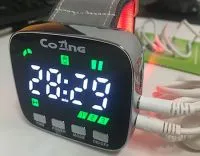 |
Four Color 10 Beam 3-in-1
Wrist Laser
In another biophysics breakthrough, new research
indicates that pulses of visible light from
a laser can be used to destroy viruses in biological
samples, such as blood. According to reports,
the visible light is actually more effective
at disrupting the virus' structure than traditional
eradication methods, such as UV or microwave
irradiation. Those other forms can also trigger
mutations within the viruses, perhaps generating
resistances
More Information Click here
|
 |
Finger
And Toe Nail Laser
Nail fungus is a common condition that begins
as a white or yellow spot under the tip of
your fingernail or toenail. As the fungal infection
goes deeper, nail fungus may cause your nail
to discolor, thicken and crumble at the edge.
It can affect several nails More Information Click here
|
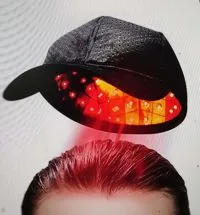 |
92 Beam
Laser Cap
Indications:
1. Seborrheic alopecia, alopecia
areata, physical alopecia, chemical alopecia.
2.
Female postpartum hair loss, female menopause
alopecia, sub-health state of hair loss, head
mites and head blood circulation poor.
3. Blocked
hair follicles, hair roots of malnutrition,hair
loss caused by overstrain nerves etc.
4. Hair
regrowth.
5. Hair Rejuvenation.
6. Alopecia Areata.
1. Treatment Time:20 Minutes, twice at each
week.
2. Easy to use, only button to control the
hair laser helmet on/off.
3. 4-18 weeks of oil
secretion improved,and hair loss will be back
to normal level.
4. 8-26 weeks,hair
thicker,more comprehensive(full),more shiny(healthy).
5. 26-52
weeks.the hair comes into the full growth
period,and hair volume increased significantly.
|
| |
|
 |
Knee Care Laser
Knee Care Laser combines massage, pressure kneading,
vibration and Laser irradiation and LED technologies
together. It can improve the blood circulation
as well as enhance the strength and stability
of the Knee More Information here
|
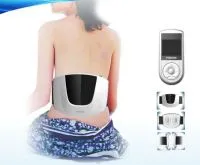 |
Waist Care Laser
Waist
Care Massager combines massage, pressure kneading,
vibration and Laser irradiation and
LED technologies together. It can improve the
blood circulation as well as enhance the strength
and stability of the lumbar region. It plays
an important role in supporting and protecting
the Lower back as well More
Information here
|
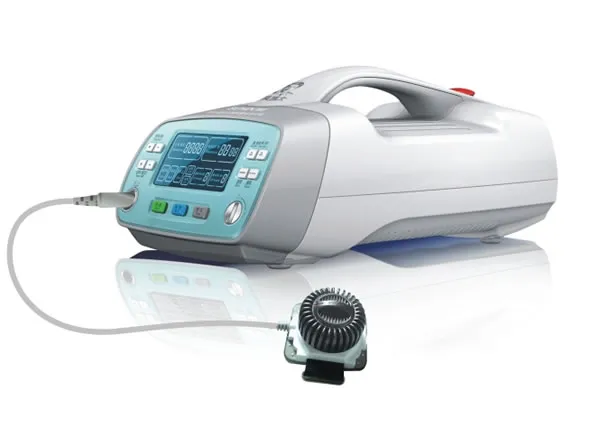 |
Low-level
laser therapy System
The laser probe provides energy
with a combination of predominantly laser light
(810nm) and peripheral laser light (650nm)
diodes to provide a distribution of laser energy
over the entire effected area. By applying
the laser energy, it triggers normal cellular
functions that lead to faster wound healing,
pain relief and accelerated functional recovery.
It is the most innovative and promising laser
therapy device released to date. More
Information here
|
|

